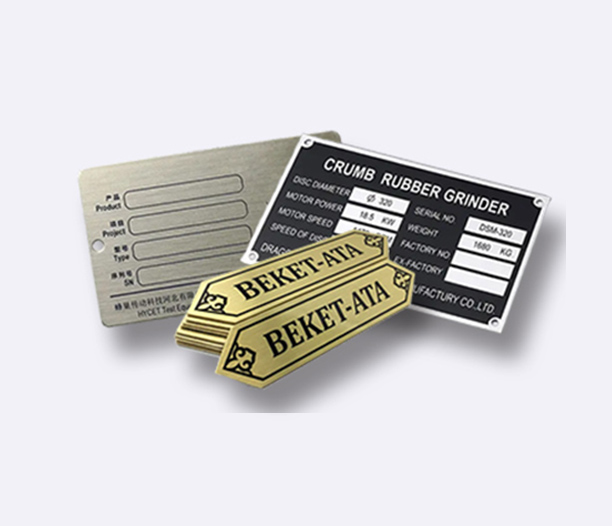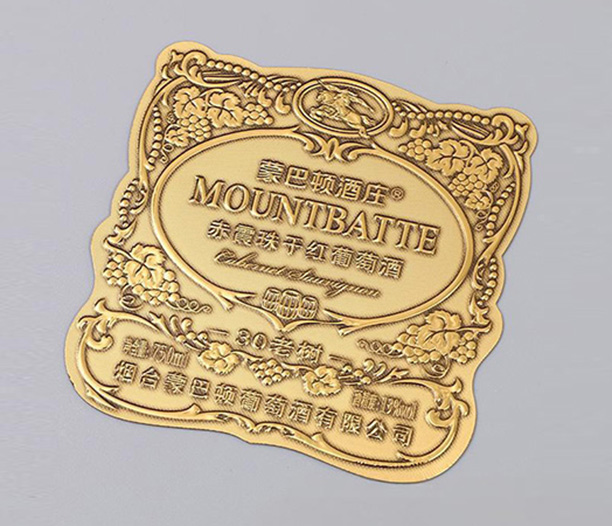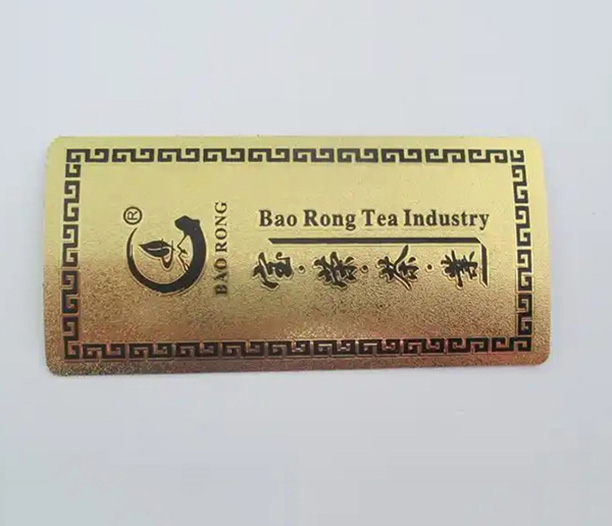In industries where extreme heat is a constant factor, such as powder coating, aerospace, automotive, and manufacturing, the need for durable identification solutions is paramount. High-temperature resistant nameplates play a critical role in these settings, providing essential information that must remain legible and intact despite exposure to high temperatures. These nameplates are not just simple labels; they are engineered products designed to withstand thermal stress, corrosion, and mechanical wear. This article delves into the world of high-temperature resistant nameplates, exploring their composition, manufacturing, applications, benefits, and common challenges. By understanding these aspects, industry professionals can make informed decisions to enhance safety, compliance, and efficiency in their operations.
High-temperature resistant nameplates are specialized identification plates made from materials that can endure temperatures typically ranging from 500°F to over 2000°F (260°C to 1100°C). They are used to display crucial data like serial numbers, safety warnings, brand logos, and operational instructions on equipment subjected to high heat. In the powder coating industry, for instance, these nameplates are affixed to ovens, curing systems, and spray booths where temperatures can soar during processing. The importance of high-temperature resistant nameplates cannot be overstated, as they ensure that vital information remains accessible, reducing the risk of accidents and improving maintenance workflows. As we proceed, we will examine key facets of these components, addressing common questions that arise in their selection and use.
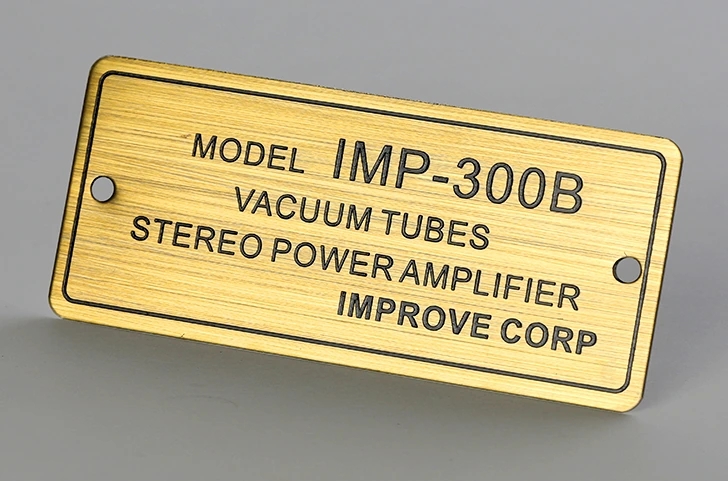
What Are High-Temperature Resistant Nameplates?
High-temperature resistant nameplates are durable labels or plates constructed from materials capable of withstanding extreme thermal conditions without degrading. Unlike standard nameplates, which might warp, fade, or peel under heat, these are designed to maintain their integrity and readability. They are commonly used in environments where equipment operates at elevated temperatures, such as industrial furnaces, engines, and powder coating systems. The primary function of high-temperature resistant nameplates is to provide permanent identification that complies with industry standards, such as those set by OSHA or ISO, ensuring that safety and operational details are always visible.
These nameplates come in various forms, including etched metal plates, ceramic labels, or composite materials, each tailored for specific temperature ranges and environmental factors. In powder coating applications, high-temperature resistant nameplates are often exposed to cyclic heating and cooling, as well as chemical exposure from coatings and cleaners. Therefore, they must resist not only heat but also abrasion, UV radiation, and moisture. The selection of high-temperature resistant nameplates depends on factors like the maximum operating temperature, required lifespan, and aesthetic needs. By choosing the right type, businesses can avoid costly replacements and ensure long-term reliability.
Materials Used in High-Temperature Resistant Nameplates
The performance of high-temperature resistant nameplates largely hinges on the materials from which they are made. Common materials include stainless steel, aluminum, ceramics, and specialty alloys like Inconel or titanium. Each material offers distinct advantages for high-temperature applications. Stainless steel, for example, is popular for its corrosion resistance and ability to withstand temperatures up to 1500°F (815°C), making it suitable for many powder coating ovens. Aluminum is lighter and cost-effective but has a lower temperature threshold, often used in moderate heat scenarios.
Ceramics are another excellent choice for high-temperature resistant nameplates, as they can endure temperatures exceeding 2000°F (1100°C) and provide excellent electrical insulation. They are often used in extreme environments, such as aerospace or power generation. Additionally, composite materials, which combine metals with heat-resistant polymers or coatings, are gaining traction. These composites can be customized for specific needs, such as enhanced adhesion or flexibility. In powder coating, where nameplates might be exposed to overspray and cleaning agents, materials with inherent resistance to chemicals are preferred. The choice of material for high-temperature resistant nameplates should align with the operational conditions to ensure durability and legibility over time.
Manufacturing Processes for High-Temperature Resistant Nameplates
The production of high-temperature resistant nameplates involves specialized manufacturing techniques to ensure they can endure harsh conditions. Common processes include etching, stamping, and laser engraving. Etching is a precise method where acid or lasers remove material to create raised or recessed text and graphics, ideal for high-temperature applications as it does not compromise the material's integrity. Stamping uses dies to impress designs into metal, providing a durable, permanent mark. Laser engraving offers high precision and is excellent for complex designs on materials like ceramics or metals.
For high-temperature resistant nameplates, post-processing steps like annealing or coating are crucial. Annealing relieves internal stresses from manufacturing, enhancing heat resistance. Powder coating is often applied as a protective layer; however, in this context, the nameplates themselves might be coated with high-temperature powders to add an extra layer of durability. The manufacturing process must ensure that adhesives or fasteners used to attach the nameplates are also heat-resistant. For instance, epoxy-based adhesives or mechanical rivets that can withstand thermal expansion are common. Quality control during manufacturing is vital to prevent defects that could lead to failure in the field. By understanding these processes, buyers can specify high-temperature resistant nameplates that meet their exact requirements.
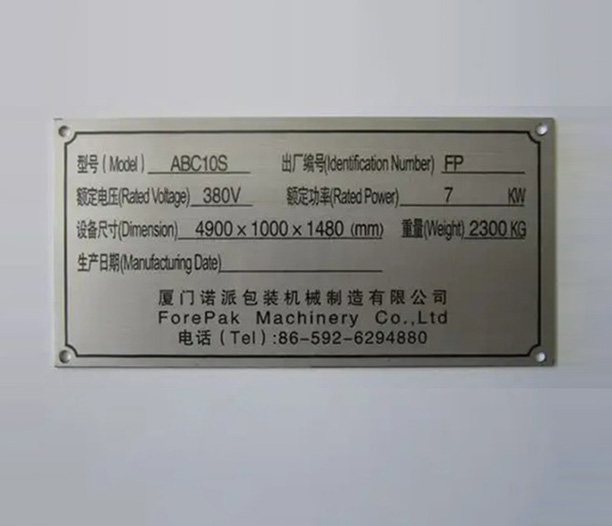
Applications in the Powder Coating Industry
High-temperature resistant nameplates are indispensable in the powder coating industry, where equipment like curing ovens, pretreatment systems, and spray guns operate at high temperatures. These nameplates are used to label equipment with safety warnings, model numbers, and maintenance schedules. For example, on a powder coating oven, a high-temperature resistant nameplate might indicate maximum temperature limits or electrical specifications, ensuring operators adhere to safe practices. This is critical for preventing accidents and maintaining efficiency.
In powder coating processes, nameplates are exposed to temperatures that can reach 400°F to 800°F (200°C to 430°C) during curing cycles. Standard labels would quickly deteriorate, but high-temperature resistant nameplates remain functional, reducing downtime for replacements. They also play a role in compliance, as regulatory bodies often require permanent identification on industrial equipment. Beyond ovens, these nameplates are used on exhaust systems, heat guns, and other components where heat buildup occurs. The versatility of high-temperature resistant nameplates makes them a staple in powder coating facilities, contributing to overall operational integrity.
Benefits of Using High-Temperature Resistant Nameplates
The advantages of high-temperature resistant nameplates extend beyond mere durability. Firstly, they enhance safety by ensuring critical information remains visible even under extreme conditions, reducing the risk of misuse or accidents. Secondly, they offer long-term cost savings by minimizing the need for frequent replacements, which can disrupt operations. High-temperature resistant nameplates are designed for longevity, often lasting the lifetime of the equipment they are attached to.
Another key benefit is compliance with industry standards. Many sectors, including powder coating, have strict regulations regarding equipment labeling. High-temperature resistant nameplates help meet these requirements, avoiding fines and legal issues. Additionally, they improve maintenance efficiency by providing clear, permanent labels that aid in troubleshooting and repairs. From an aesthetic perspective, these nameplates can be customized with logos and colors, enhancing brand identity without sacrificing performance. In summary, investing in high-temperature resistant nameplates is a smart choice for any business operating in high-heat environments, as they provide reliability, safety, and efficiency.
Common Issues with High-Temperature Resistant Nameplates
Despite their robustness, high-temperature resistant nameplates can encounter problems if not properly selected or installed. One common issue is adhesive failure, where the bonding agent degrades under heat, causing the nameplate to peel off. This often occurs if the adhesive is not rated for the operating temperature. To avoid this, it's essential to use high-temperature adhesives or mechanical fasteners. Another problem is fading or discoloration of the text or graphics, which can happen due to prolonged UV exposure or chemical contact. Choosing materials with UV-resistant coatings can mitigate this.
Warping or cracking is another challenge, particularly if the nameplate material cannot handle thermal cycling. For instance, some plastics or low-grade metals may deform under repeated heating and cooling. Opting for ceramics or high-grade alloys can prevent this. Additionally, poor legibility over time is a concern, especially if the engraving method is not deep enough. Laser-etched high-temperature resistant nameplates tend to fare better in this regard. Installation errors, such as improper surface preparation, can also lead to issues. Surfaces must be clean and smooth to ensure adhesion. Finally, cost misconceptions might lead businesses to choose cheaper alternatives that fail prematurely. It's important to view high-temperature resistant nameplates as a long-term investment rather than a short-term expense. By addressing these common problems proactively, users can maximize the effectiveness of their nameplates.
High-temperature resistant nameplates are vital components in industries where heat is a constant challenge. From their material composition to manufacturing processes and applications, these nameplates offer a blend of durability, safety, and compliance. In the powder coating field, they ensure that equipment remains properly identified, enhancing operational efficiency and reducing risks. While common issues like adhesive failure or fading can arise, these can be mitigated through careful selection and installation. As technology advances, we can expect even more innovative solutions in high-temperature resistant nameplates, further solidifying their role in industrial settings. By prioritizing quality and understanding the key aspects discussed, businesses can leverage these nameplates to achieve greater reliability and success.
In conclusion, high-temperature resistant nameplates are not just labels; they are engineered solutions that withstand the test of time and temperature. Whether you are involved in powder coating or other high-heat industries, investing in the right high-temperature resistant nameplates is a step toward safer and more efficient operations.



